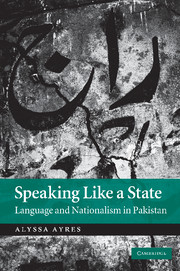Book contents
- Frontmatter
- Contents
- List of illustrations
- List of tables
- Acknowledgments
- Note on transliteration
- Introduction
- 1 Articulating a new nation
- 2 Urdu and the nation
- 3 The nation and its margins
- 4 The case of Punjab, part I: elite efforts
- 5 The case of Punjab, part II: popular culture
- 6 History and local absence
- 7 Bringing back the local past
- 8 Speaking like a state: language planning
- 9 Religion, nation, language
- 10 Conclusion
- Bibliography
- Index
5 - The case of Punjab, part II: popular culture
Published online by Cambridge University Press: 25 August 2009
- Frontmatter
- Contents
- List of illustrations
- List of tables
- Acknowledgments
- Note on transliteration
- Introduction
- 1 Articulating a new nation
- 2 Urdu and the nation
- 3 The nation and its margins
- 4 The case of Punjab, part I: elite efforts
- 5 The case of Punjab, part II: popular culture
- 6 History and local absence
- 7 Bringing back the local past
- 8 Speaking like a state: language planning
- 9 Religion, nation, language
- 10 Conclusion
- Bibliography
- Index
Summary
“So, this Punjabi is whose language?”
“It's the hicks' language.”
“Who are these hicks?”
“The people who live in villages.”
“What percentage are they?”
“They're about seventy-five percent.”
“Skit Number 5,” The Punjabi Language Will Never DieThe Punjabiyat movement has arisen due to the work of cultural entrepreneurs focused on crafting “high” literature in their language to give it a voice in culturally prestigious arenas, an important aspect of the argument that the language deserves its rightful place on the world stage (not to mention the national stage). At the same time, an intriguing development has been unfolding in the segments of Punjabi-speaking Pakistan that illustrates perduring attachment to the language even in the face of a national hierachization that places it at subordinate levels. The brief skit which begins this chapter encapsulates the symbolic economy: the questioner runs through a whole cast of Pakistani ethnic ideal-types, first asking a Sindhi what language he likes to speak (“Sindhi”), then a Pashtun and a Baloch (who answer “Pashto” and “Balochi”). But when the questioner poses the same question to a Punjabi, the latter answers “Urdu.” When the questioner presses the Punjabi ethnic type further on the matter of the Punjabi language – who speaks it, and where – he receives answers designed to highlight the peculiar relationship between Punjabi, Urdu, and the Punjab.
- Type
- Chapter
- Information
- Speaking Like a StateLanguage and Nationalism in Pakistan, pp. 87 - 104Publisher: Cambridge University PressPrint publication year: 2009



